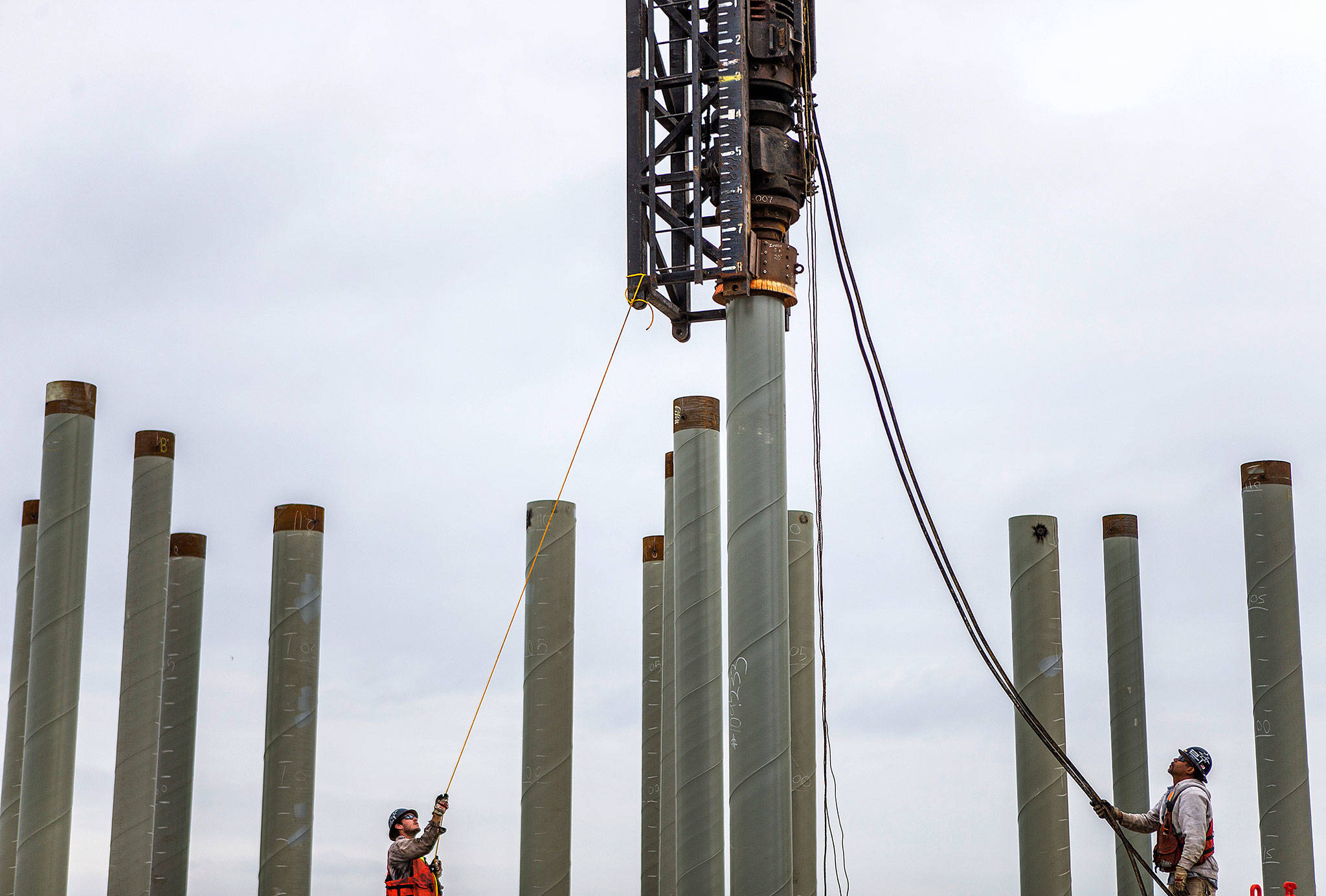EVERETT — The Port of Everett is preparing for an economic boom, but for now you’ll just have to settle for the sounds of booms.
A $36 million project is underway to strengthen the port’s largest container dock and add to the port’s economic impact. When completed, the South Terminal dock will accommodate larger vessels and heavier cargo, including parts for the Boeing 777x.
More than 340 steel piles will be driven into the the existing 700-foot dock, and that means — here comes the boom of the pile driver.
If you’re near Everett’s waterfront or downtown, “You’ll hear the booms,” said Steve Hager, the port’s senior project planner.
“Actually, it will sound more like a series of bangs,” said John Klekotka, the chief of engineering and planning.
If it’s any consolation, the pile driver is limited to 2,000 blows a day.
And, yes, someone at the construction site is responsible for the daily count, said Laura Gurley, a port planner.
The contractor, Advanced American Construction, plans to set about five piles a day, with installation scheduled to wrap up by Feb. 15.
Neighbors have been alerted, port officials said.
But protecting another group of residents — fish, seals and whales — is trickier and requires specialists.
Marine mammals depend on sound to communicate and locate food. Construction noise, or any loud underwater disturbance, can disorient, harm or even kill marine life.
“We will have people on site throughout the project looking for specific animals,” Gurley said.
So far, 32 piles have been partially driven through the dock using a low-impact, vibrating hammer.
“We vibrate them in as much as we can,” Gurley said. “We save the last little bit for the pile driver.”
On Friday, construction workers, biologists and researchers gathered at the South Terminal to test the pile driver and its sound levels.
Peering over the side of the dock, Justin Morgan, an acoustician, was ready with the mic. He lowered a hydrophone, an underwater microphone, into the water to record and measure the boom of the pile driver.
The results will be used to determine if the pile driver — or hydraulic hammer, as it’s sometimes called — is breaching noise thresholds, Morgan said. He works with The Greenbusch Group, a consulting firm with offices in Seattle and Ohio.
About 30 yards away, biologist Jean Olson stood on a platform jutting out from the dock and scanned the water with binoculars.
“You look for little heads and fins,” said Olson with Hart Crowser, a Seattle consulting firm. If fish, seals or orcas wander too close, Olson has the authority to halt work until the animals retreat to a safe distance.
The day before, a pod of transient orcas, the kind that eat everything — not just salmon — caravanned through Port Gardner.
“Every sighting goes into a spreadsheet,” Olson said, reaching for a handheld computer tucked into her jacket.
The pile driver is like a circus strongman. Its aim is to hammer the top of the steel pole over and over until it’s securely pinned to the sea floor.
Factors include terrain, soil conditions and the pile itself — the largest are 110 feet long and 2 feet wide.
One recent invention has significantly lowered the boom underwater. That would be a “Bubble Curtain,” a series of perforated metal rings and plastic that surround the underwater portion of the pile.
Pumping in compressed air produces bubbles. The bubbles break up the sound waves, reducing their intensity and lowering the volume.
The morning’s first boom had some scrambling for their ear plugs.
It was followed by a noisy but steady “kerchunk, kerchunk, kerchunk.” The steel pile sunk deeper and deeper.
The first phase of the project, which was completed in 2015, strengthened 140 feet of the dock.
This phase will reinforce the remaining 560 feet and upgrade the dock’s electrical system so ships can plug into shore power when they’re docked.
“Larger vessels are going to be calling on the Port of Everett soon,” Glen Bachman, Port Commission president said at a gathering last week.
In terms of dollars and scope, “this is the largest maritime construction project on the West Coast right now,” said Lisa Lefeber, the port’s acting chief executive.
The port has set aside $14 million for the $36 million project. Plus, it’s receiving nearly $11.8 million in grants and $10.2 million in federal and state loans. The entire project is expected to be completed in December 2019.
Janice Podsada; jpodsada@heraldnet.com; 425-339-3097; Twitter: JanicePods
How to complain
Have an issue? Call the Port of Everett’s Construction & Noise Hotline at 425-388-0269.
Talk to us
> Give us your news tips.
> Send us a letter to the editor.
> More Herald contact information.



























